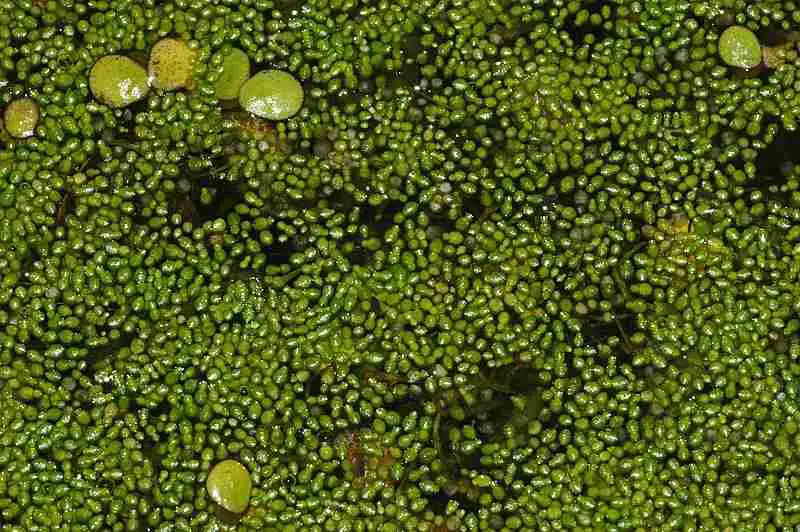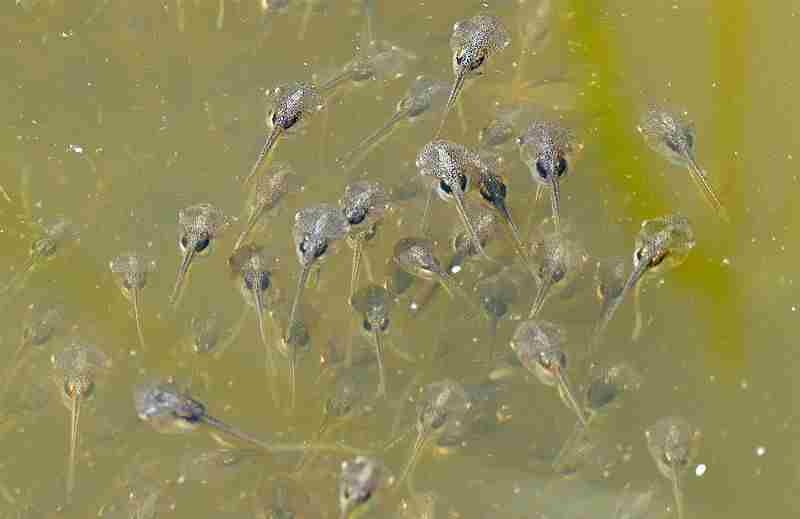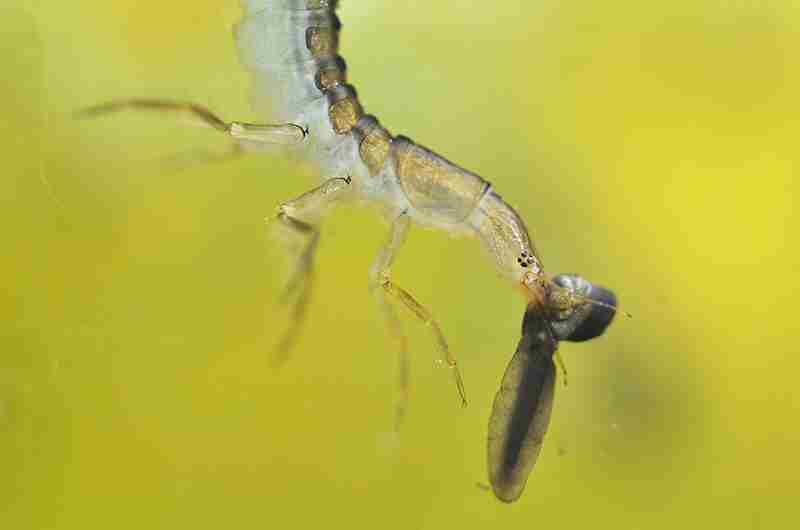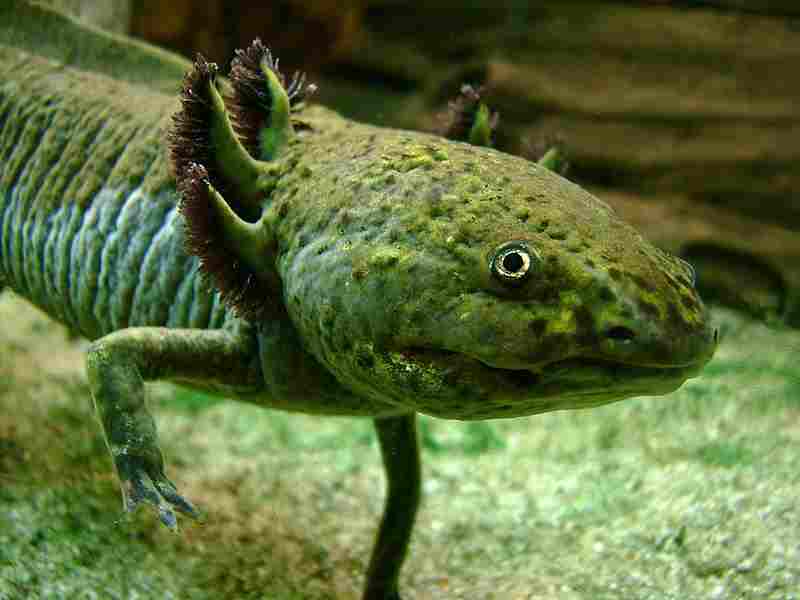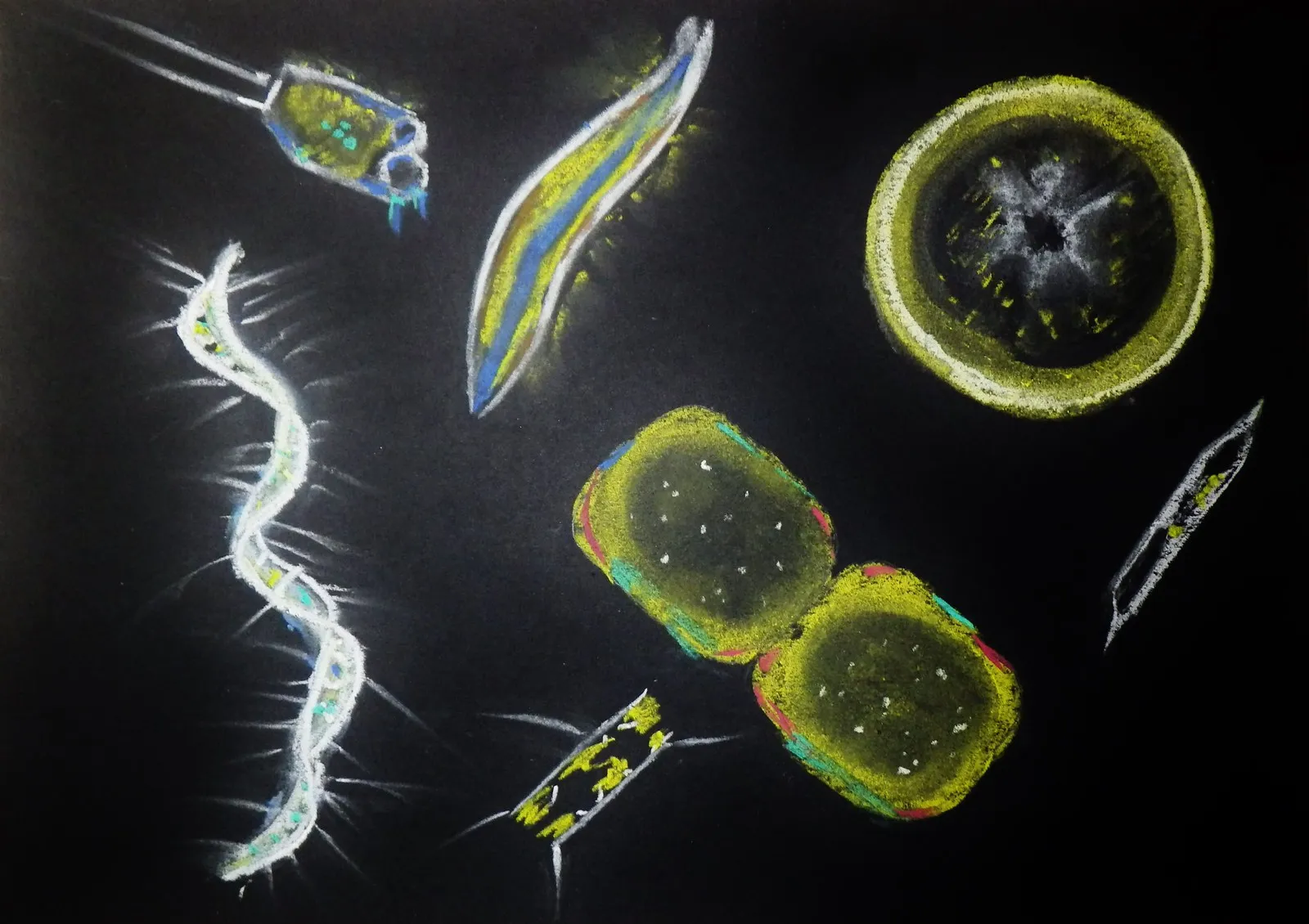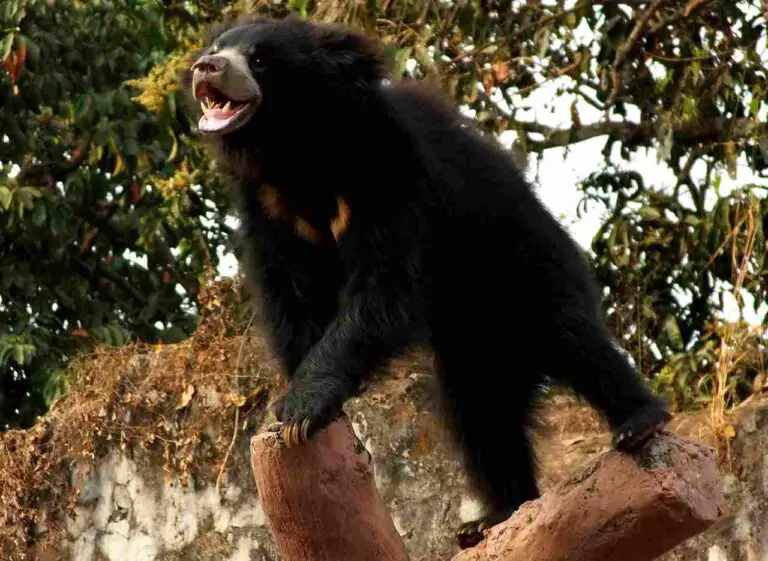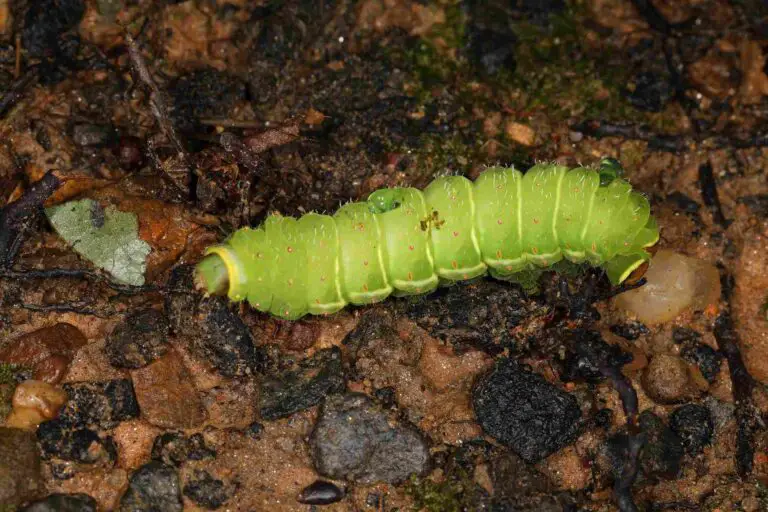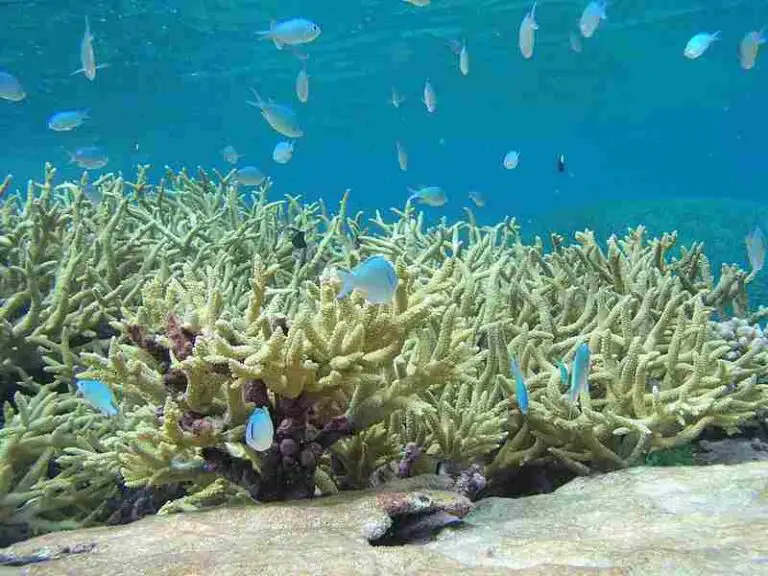Lake Food Chain | Lake Food Web
Lake food chain is a linear ecological model that is made up of producers like duckweeds, primary consumers like copepods, secondary consumers like minnows, and tertiary consumers like ospreys.
Lake food web is a dense and multidimensional ecological model that comprises of multiple producers and consumers performing multiple trophic functions simultaneously.
This article discusses lake food chain and food web respectively, as outlined below;
-Lake Food Chain
Lake food chain comprises of producers like; duckweeds and diatoms, primary consumers like copepods and tadpoles, secondary consumers like minnows and bluegills, and tertiary consumers like bass and ospreys.
1). Producers in a Lake: Biotic Components of the Lake Food Chain
Producers in a lake ecosystem, are a group of autotrophic organisms that occupy the basal level of the food chain.
Examples of primary producers in a lake ecosystem are; cyanobacteria, diatoms, water lilies, water lettuce, water hyacinths, watermeal, duckweed, bulrushes and cattails. Below is a brief discussion of their individual attributes and ecological functions.
1. Cyanobacteria
In terms of their characteristics, cyanobacteria can be described as unicellular or colonial, photosynthetic bacteria capable of nitrogen fixation. Often found in blue-green algal blooms.
They are primary producers that convert light energy from the sun into organic compounds, contributing to the lake's food chain. Some cyanobacteria fix atmospheric nitrogen, enriching the nutrient pool.
2. Diatoms
Diatoms are a group of microscopic, single-celled algae with intricate silica shells.
They function as key primary producers that contribute to the lake's oxygen cycle/production and serve as a primary food source for some herbivorous organisms.
3. Water Lilies
Water lilies are aquatic flowering plants with broad leaves that float on the water's surface.
They are photosynthetic producers that provide shade, habitat, and food resources for various organisms. Their leaves also reduce light penetration into the water column, affecting the lake's underwater environment.
4. Water Lettuce
Water lettuces can be described as floating aquatic plants with rosettes of textured leaves.
They act as floating producers, which shade the water and provide habitat for some lake fauna. They contribute to nutrient uptake and may help control the growth of algae by competing (that is; with the algae) for resources.
5. Water Hyacinths
Water hyacinths are a group of fast-growing floating plants with showy purple flowers.
They are efficient producers that cover the water's surface, often reducing underwater solar penetration and suppressing algal growth. They provide habitat and can absorb excess nutrients.
6. Watermeal
Base on their physical characteristics, watermeal plants are tiny, free-floating green plants that resemble grains of meal.
Microscopic but prolific, watermeal contributes to the recycling of nutrients, and provides food for small herbivores, forming an essential part of the lower trophic levels.
7. Duckweed
Duckweeds are small, floating plants with rapid growth patterns.
Like other lake producer, they may act as nutrient absorbers, contributing to water quality management. They also provide cover for some organisms and widely serve as a food source for various aquatic animals.
8. Bulrushes
Bulrushes are tall, emergent plants with cylindrical stems and seed heads.
They provide habitat and shelter for aquatic organisms. They also stabilize the shoreline and mitigate erosion, while contributing to nutrient uptake from the water.
9. Cattails
Cattails can be described as tall, slender plants with distinctive brown, cylindrical seed heads.
The above description clearly indicates physical similarity between cattails and bulrushes, which can be attributed to their genealogical proximity.
Although both bulrushes and cattails belong to the perennial herbaceous genus Typha and may be interchangeably referred to with taxonomic name; Typha latifolia, these two plants are not entirely the same. Bulrushes have more-rounded seed heads and slightly narrower leaves than most cattails, and both plants differ in their geographic abundance.
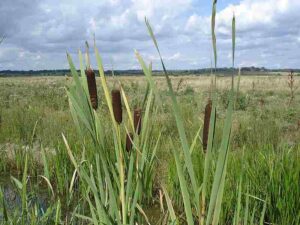
Cattails act as habitat and nesting sites for birds. Cattails play a role in nutrient removal, contributing to water purification.
In a lake ecosystem, these diverse producers collectively contribute to nutrient cycling, oxygen production, and the overall sustainability of the aquatic environment. They form the foundation of the food web, supporting various trophic levels and influencing the structure and dynamics of the entire lake ecosystem.
2). Primary Consumers in a Lake Ecosystem
Primary consumers in a lake ecosystem are important biotic factors known for their dependence on primary producers as a major source of sustenance.
Examples of primary consumers in a lake ecosystem are; tadpoles, mayfly nymphs, copepods, zebra mussel, and spiny water flea. Their basic characteristics and functions are discussed below;
1. Tadpoles
Tadpoles in lake ecosystems represent the larval stage of amphibians, typically possessing a long tail and gills.
They feed on algae, detritus, as well as both non vascular and vascular plant materials, converting the components of these primary producers into their own biomass. Tadpoles serve as a crucial link between plant-based resources and non-herbivorous consumers in higher trophic levels.
2. Mayfly Nymphs
Mayfly nymph is the aquatic, immature stage of mayflies with distinct body segments and often gill tufts.
Being herbivorous or detritivorous, mayfly nymphs contribute to nutrient cycling by consuming organic materials. They are also an important food source for predatory organisms in higher trophic levels, including fish.
3. Copepods
Copeopods can be described as small, planktonic crustaceans with a single eye and prominent antennae.
The herbivorous copepods consume phytoplankton and detritus, transferring energy from primary producers to higher lake consumers. They are a key component of the zooplankton community.
4. Zebra Mussel
Zebra mussels are small, invasive bivalve mollusks with a striped shell.
They function as filter feeders that extract phytoplankton and suspended particles from the water, impacting the trend of nutrient cycling. Their presence can alter the composition of the plankton community and affect water clarity.
5. Spiny Water Flea
Spiny water flea is a small, planktonic crustacean that can be identified by its long, tail spine.
It is a zooplankton predator that preys on smaller organisms, including some other zooplankton. The spiny water flea influences the structure of the zooplankton community and can have cascading effects on the food chain. Often, their rate of predation on other zooplankton leads to adverse population declines that reduce the availability of planktonic food sources for fish.
Although they are predatory, spiny water fleas are classified as primary consumers due to other biological factors like their size, planktonic nature, scale of consumption, and role as prey for secondary consumers.
Overall Functions of Primary Consumers
In general, primary consumers in a lake ecosystem serve various functions that include energy transfer, nutrient cycling, food provision for higher consumers, population regulation, and influence on overall biotic interactions.
Primary consumers transfer energy from primary producers to higher freshwater consumers, facilitating the continuous flow of energy through the food chain.
By consuming plant material and detritus, primary consumers contribute to nutrient cycling in the lake, releasing nutrients in a form accessible to other organisms.
Primary consumers also serve as a vital food source for predators in higher trophic levels, including fish, insects, and other aquatic organisms.
The abundance and activity of primary consumers can influence the population dynamics of primary producers and, in turn, impact the structure, composition, and biological performance of the entire ecosystem.
Primary consumers are involved in complex ecological interactions, such as predation and competition, which define the dynamics of the lake ecosystem.
The characteristics and functions of primary consumers are essential factors that can be used to evaluate the intricate relationships within lake ecosystems and the factors influencing their vitality and sustainability.
3). Secondary Consumers in a Lake: Biotic Components of the Lake Food Chain
Secondary consumers in a lake ecosystem are a group of important organisms that occupy the third trophic level of the food chain and feed mainly on primary consumers.
Examples of secondary consumers in a lake are; crayfish, brine shrimp, frogs, minnows, and bluegill fish.
1. Crayfish
Freshwater crayfish are aquatic crustaceans with a hard exoskeleton, claws, and a segmented body.
They are classified as secondary consumers that feed on primary consumers (like aquatic insects and tadpoles) as well as detritus. They have a role to play in regulating populations of smaller organisms, and contribute to nutrient cycling.
2. Brine Shrimp
Brine shrimp are a group of small, planktonic crustaceans with a slender body and leaf-like appendages, that occur in lakes, ponds and wetlands.
As secondary consumers, they feed on phytoplankton and smaller zooplankton. They also serve as a trophic link between primary producers and higher consumers, especially in aquatic ecosystems.
3. Frogs
Frogs are amphibians with moist skin, long hind limbs, and the ability to jump.
In freshwater, they are secondary consumers that prey on insects, small fish, and non-insect invertebrates like worms. Frogs contribute to controlling populations of primary consumers and also participate in nutrient cycling.
4. Minnows
Minnows can be described as small freshwater fish with streamlined bodies and often silver scales.
They are secondary consumers that feed on smaller fish, invertebrates, and zooplankton. Minnows serve as prey for larger predators while playing a role in regulating the abundance of smaller aquatic organisms.
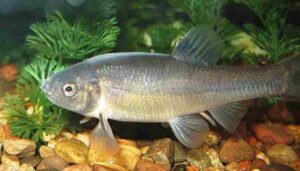
5. Bluegill Fish
Bluegill fish are a type of sunfish with distinctive blue markings on the gill covers.
They function as secondary consumers in lakes, preying on smaller fish, insects, and zooplankton. Bluegill fish contribute to the regulation of populations in the lake's ecosystem and are important prey for larger predators.
Overall Functions of Secondary Consumers in a Lake Ecosystem
The collective functions of secondary consumers in a lake ecosystem are; population control, energy transfer, control of predation dynamics, nutrient cycling, and overall biotic sustenance.
Secondary consumers help regulate the populations of primary consumers, preventing resource depletion or overpopulation and maintaining ecological stability.
By consuming primary consumers, secondary consumers transfer energy from lower trophic levels to higher trophic levels in the food web.
Secondary consumers engage in predator-prey relationships, influencing the distribution and adaptations of their prey species.
Through their feeding activities and subsequent excretion, secondary consumers also contribute to the recycling of nutrients in the lake ecosystem.
Secondary consumers participate in complex ecological interactions, influencing the structure and functionality of the entire aquatic community.
Both the characteristics and functions of secondary consumers contribute substantially to the dynamics of lake ecosystems and the interconnected relationships that contribute to their stability and resilience.
4). Tertiary Consumers in a Lake Ecosystem
Tertiary consumers are often the apex predators at the highest trophic level of the lake food chain.
Examples of tertiary consumers in a lake ecosystem are; northern pike, great blue heron, bass, otter, trout, salmon, osprey, and pied-billed grebe. Below is a discussion of their characteristics and functions;
1. Northern Pike
The northern pike is a large predatory fish with elongated bodies, sharp teeth, and a voracious appetite.
Northern pikes are tertiary consumers that prey on smaller fish, including secondary consumers like bluegills and minnows. They play an effective role in regulating the abundance of fish populations within the lake.
2. Great Blue Heron
Great blue heron is a large wading bird with a long neck, bill, and distinctive blue-gray plumage.
These birds are tertiary consumers that mainly feed on fish, amphibians, and small mammals, while occasionally consuming invertebrates as a dietary supplement. They contribute to controlling populations of smaller vertebrates in the lake ecosystem.
3. Bass
Bass species like the largemouth bass are freshwater fish with a stout body morphology and a general reputation for being aggressive predators.
Largemouth bass are tertiary consumers preying on smaller fish, crayfish, and other aquatic organisms. Bass help maintain ecological stability by controlling populations of secondary consumers.
4. Otter
Otters are aquatic mammals with streamlined bodies, webbed feet, and a playful, active behavior.
They are tertiary consumers that feed on fish, crayfish, and amphibians. Otters play a role in controlling the abundance of lower aquatic organisms, contributing to the vitality of the lake ecosystem.
5. Trout and Salmon
Trout and salmon are cold-water fish species with streamlined bodies and often migratory behavior.
They are both tertiary consumers that prey on smaller fish, insects, crustaceans, and other invertebrates within reach. Trout and salmon are important regulators of lower trophic levels and are themselves prey for other predators like larger fish and birds.
In some food chains, they are classified as secondary consumers due to their smaller size and predatory capacity than other aquatic apex predators. However, such decisions depend on the compositional details of each trophic level.
6. Osprey
The osprey is a relatively large raptor with distinctive black and white plumage, as well as a specialized diet of fish.
Ospreys are tertiary consumers that primarily feed on fish, particularly those near the water's surface. They help control fish populations and contribute to the dynamics of the lake's food chain/web/energy pyramid.
7. Pied-billed Grebe
The pied-billed grebe is a waterfowl that also possesses a distinctive plumage with brown and pale-grey colors, and is known for its diving behavior.
As tertiary consumers, grebes prey on fish, aquatic insects, and small crustaceans. These birds contribute to the regulation of aquatic populations, particularly fish and invertebrates.
Overall Functions of Tertiary Consumers in the Lake Ecosystem
In general, tertiary consumers in lakes play roles like population control, top-down regulation, and energy transfer.
Tertiary consumers play a crucial role in controlling the populations of secondary consumers and maintaining a balanced and healthy ecosystem.
As apex predators, tertiary consumers influence the structure and adaptive trends of organic populations in lower trophic levels, affecting the abundance and distribution of species throughout the food chain.
Tertiary consumers transfer energy from lower trophic levels to themselves, thereby facilitating the flow of energy through the entire lake ecosystem.
Lastly, tertiary consumers engage in complex ecological interactions, including predator-prey relationships, which shape the dynamics of the lake community.
The characteristics and functions of tertiary consumers which are discussed above, are essential for defining the top-down regulatory processes that influence the structure and stability of lake ecosystems.
5). Decomposers and Detritivores in a Lake
Decomposers and detritivores represent other groups of organisms that contribute to the processes of the lake food chain.
While they are not confined to any particular level, lake decomposers and detritivores are instrumental to some key dynamics like the conservation of energy and cycling of abiotic resources.
Examples of decomposers and detritivores in a lake ecosystem are; bacteria, fungi, amphipods, isopods, some aquatic snails, and worms. An outline of their basic attributes is provided below;
1. Bacteria
In lakes, bacteria occur as microscopic single-celled organisms with diverse shapes and metabolic functions.
They are decomposers that break down organic matter into simpler compounds, demonstrating their pivotal role in nutrient cycling by releasing essential elements from organic wastes, back into the ecosystem.
2. Fungi
Fungi can be described as eukaryotic organisms with filamentous structures (called hyphae) and reproductive structures (like mushrooms).
Functions: Decomposers involved in breaking down complex organic compounds, particularly lignin and cellulose. Fungi contribute to the biodegradation of plant material in aquatic environments.
3. Amphipods
Amphipods are a group of small, shrimp-like crustaceans that have flattened bodies and laterally compressed appendages.
Based on ecological function, amphipods can be described as detritivores that consume decaying plant material, contributing to the breakdown of organic materials. They serve as an important link in transferring energy from detritus to higher lake consumers.
4. Isopods
Isopods are small, dorso-ventrally flattened crustaceans with seven pairs of legs.
They act as detritivores that feed on decaying plant material, helping break down organic matter. Isopods are instrumental in aquatic nutrient cycling and contribute to the overall vitality of the lake ecosystem.
5. Aquatic Snails
Aquatic snails can be generally described as gastropod mollusks with a coiled shell and a broad, flat foot.
They are detritivores that graze on algae and consume decaying plant material. Aquatic snails contribute to nutrient cycling by processing organic matter and influencing the growth of algae.
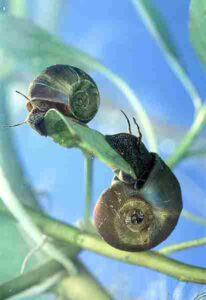
6. Worms
Worms in lakes are soft-bodied, elongated invertebrates with a segmented body and a simple nervous system.
Like other detritivores, they are involved in the breakdown of organic matter, including plant debris and detritus from other organisms. Worms enhance soil structure and sedimentary nutrient availability in aquatic habitats.
Overall Characteristics and Functions of Decomposers and Detritivores in Lake Ecosystems
As a group, the attributes of decomposers and detritivores in lake ecosystems can be broadly delineated into; organic matter breakdown, nutrient cycling, detritus processing, enhancement of decomposition efficiency, and habitat engineering.
Decomposers, such as bacteria and fungi, break down complex organic matter into simpler compounds, initiating the decomposition process.
Also, decomposers and detritivores release nutrients back into the ecosystem in a form that can be utilized by primary producers, contributing to nutrient cycling.
Detritivores, including amphipods, isopods, snails, and worms, play a key role in processing detritus, influencing the availability of organic matter for other organisms.
Decomposers and detritivores accelerate the decomposition of organic material, influencing the turnover of nutrients and the overall productivity of the lake ecosystem.
Detritivores, such as worms, contribute to the physical structure of the lake bottom through burrowing activities, influencing sediment composition and oxygen availability.
Understanding the roles of decomposers and detritivores is crucial for appreciating their contribution to nutrient cycling, organic matter breakdown, and the overall functioning of lake ecosystems.
-Lake Food Web
The lake food web is a relatively complex ecological structure that is formed from multiple, multidimensional interactions between various producers and consumers in lakes.
To add simplicity to the study of the lake food web, its complex structure can be dissembled into hypothetic food chains that are linked to each other. A number of such chains are discussed in this section. Due to the recurrence of many organisms in multiple food chains, some of the descriptions are also repetitive.
1). Food Chain 1: A Component of the Lake Food Web
Components: Diatoms, watermeal, bulrushes, water lettuce (Trophic Level 1)→Tadpoles, copepods, spiny water fleas (Trophic Level 2)→Crayfish, frogs (Trophic Level 3)→Northern pike, bass, pied-billed grebe (Trophic Level 5)
*Trophic Level 1: Primary Producers
Primary producers in Chain 1 of the lake food web are; diatoms, watermeal, bulrushes, and water lettuces.
1. Diatoms
Are microscopic algae with silica shells, primary photosynthesizers.
They convert sunlight into energy through photosynthesis, forming the foundation of the food chain. Their activities facilitate energy storage from sunlight, in organic compounds.
2. Watermeal
Are small-sized, free-floating aquatic plants.
They are characterized by rapid growth and reproduction, which contribute to the availability of plant-based resources. They also facilitate energy transfer to higher trophic levels.
3. Bulrushes
Bulrushes are emergent aquatic plants with cylindrical stems.
They provide habitat, stabilize the shoreline, and contribute to nutrient uptake. Their structure facilitates the transfer of energy to organisms in the next trophic level.
4. Water Lettuce
Water lettuces are floating aquatic plants with rosettes of textured leaves.
They contribute to nutrient uptake, provide habitat, and shade. Energy transfer occurs as these plants support herbivores and facilitate the development of the next trophic level.
*Trophic Level 2: Primary Consumers
Primary consumers in Food Chain 1 are; tadpoles, copepods and spiny water fleas.
1. Tadpoles
Tadpoles are the larval stage of amphibians, and primarily herbivores.
They consume primary producers, facilitating the transfer of energy from plants to animals, and form a link in energy transfer to higher trophic levels.
2. Copepods
Copepods are small planktonic crustaceans.
They are herbivores that graze on phytoplankton, facilitating the transfer of energy from primary producers to the next trophic level.
3. Spiny Water Fleas
Spiny water fleas are planktonic crustaceans with a long tail spine.
As zooplankton predators, they contribute to the regulation of phytoplankton populations. Energy transfer occurs as they consume both copepods and phytoplankton.
*Trophic Level 3: Secondary Consumers
Crayfish and frogs represent the secondary consumers in Chain 1.
1. Crayfish
Are aquatic crustaceans, and omnivores.
They feed on tadpoles, copepods, and detritus, facilitating energy transfer from primary consumers. Serve as a link to the next trophic level.
2. Frogs
Frogs are amphibians and insectivores.
They consume tadpoles, copepods, and other invertebrates. Facilitate energy transfer from primary consumers and contribute to the dynamics of the trophic cascade.
*Trophic Level 4: Tertiary Consumers
The tertiary consumers in Chain 1 of the lake food web include; northern pike, bass; and pied-billed grebe.
1. Northern Pike
Northern pike are large predatory fish that can be found in lakes.
They feed on crayfish, frogs, and smaller fish, facilitating energy transfer from secondary consumers. Represent the top predators in the lake ecosystem.
2. Bass
Bass can be described as freshwater fish, with carnivorous behavior.
They are predators that consume crayfish, frogs, and smaller fish. They also facilitate energy transfer from lower trophic levels to themselves.
3. Pied-billed Grebe
Pied-billed grebes are waterfowl with a diving behavior.
They are predators that consume fish, crustaceans, and aquatic insects. Also facilitate energy transfer from fish and contribute to the regulation of lower trophic levels.
2). Food Chain 2
Components: Cyanobacteria, water hyacinths, water lettuce, cattails (Trophic Level 1)→Mayfly nymphs, tadpoles (Trophic Level 2)→Brine shrimps, minnows (Trophic Level 3)→Heron, salmon, trout (Trophic Level 5)
*Trophic Level 1: Primary Producers
Primary producers in Food Chain 2 are; cyanobacteria, water hyacinths, water lettuces, and cattails. Below is a brief outline of their individual characteristics and functions;
1. Cyanobacteria
Cyanobacteria are photosynthetic bacteria, often forming colonies in aquatic environments.
They convert sunlight into energy through photosynthesis, serving as the primary producers at the base of the food web. Facilitate energy transfer from sunlight to organic compounds.
2. Water Hyacinths
Water hyacinths are floating aquatic plants with showy flowers.
They function as photosynthetic producers that provide habitat and cover for aquatic organisms. Contribute to the availability of plant-based resources, supporting the next trophic levels.
3. Water Lettuce
Water lettuces are also floating aquatic plants, with rosettes of textured leaves.
They contribute to nutrient uptake, provide habitat, and shade. Their growth supports herbivores and facilitates energy transfer to higher trophic levels.
4. Cattails
Cattails are emergent aquatic plants with cylindrical stems.
They provide habitat, stabilize the shoreline, and contribute to nutrient uptake. Also facilitate energy transfer to organisms in the next trophic level.
*Trophic Level 2: Primary Consumers
Primary consumers in Chain 2 include mayfly nymphs and tadpoles.
1. Mayfly Nymphs
Mayfly nymph is the aquatic developmental stage of mayflies with gill tufts.
They have herbivorous or detritivorous behaviors and feed on algae and detrital matter. Like other organisms, they facilitate energy transfer, by consuming primary producers and serving as a link to higher trophic levels.
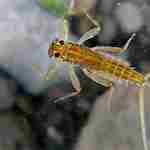
2. Tadpoles
Tadpoles are the herbivorous larval stage of amphibians.
They consume primary producers, contributing to energy transfer from autotrophs to heterotrophs in lakes. Form a link in the transfer of energy to the next trophic level.
*Trophic Level 3: Secondary Consumers
The secondary consumers in this segment of the lake food web are; brine shrimps, and minnows.
1. Brine Shrimps
Brine shrimps are small, planktonic crustaceans with leaf-like appendages.
They can be described as herbivores that consume phytoplankton, facilitating the transfer of energy from primary producers. Serve as prey for organisms in the next trophic level.
2. Minnows
Minnows are small freshwater fish with streamlined bodies.
They are omnivores that consume smaller fish, invertebrates, and zooplankton. Facilitate energy transfer from lower trophic levels to themselves.
*Trophic Level 4: Tertiary Consumers
Heron, salmon and trout represent the tertiary consumers here.
1. Heron
Heron is a large wading bird with a long neck and bill.
As predatory birds, herons feed on fish, amphibians, and invertebrates. Facilitate energy transfer from fish and contribute to the regulation of lower trophic levels.
2. Salmon and Trout
Salmon and trout are both cold-water fish with streamlined bodies, often with migratory behavior.
They are carnivorous fish that prey on smaller fish and invertebrates. Facilitate energy transfer from lower trophic levels to themselves and serve as prey for apex predators.
3). Food Chain 3: A Component of the Lake Food Web
Components: Duckweed, diatoms, water lilies (Trophic Level 1)→Zebra mussels, copepods, mayfly nymphs (Trophic Level 2)→Frogs, crayfish, small crabs (Trophic Level 3)→Bass, northern pike (Trophic Level 5)
*Trophic Level 1: Primary Producers
The primary producers are; duckweed, diatoms and water lilies.
1. Duckweed
Are small, surface-dwelling aquatic plants known to grow rapidly.
Duckweeds are photosynthetic producers that provide habitat, shade, and contribute to nutrient uptake. Facilitate energy transfer from sunlight to organic compounds.
2. Diatoms
Diatoms are microscopic algae that possess silica shells.
They are primary photosynthesizers that convert solar radiation into chemical bioenergy, forming the base of the food web. Their activities facilitate energy transfer to higher trophic levels.
3. Water Lilies
Water lilies are aquatic angiosperms which are distinguished by their broad leaves.
They are photosynthetic producers that provide shade, habitat, and refuge to some lake organisms. Facilitate energy transfer and support the development of the next trophic levels.
*Trophic Level 2: Primary Consumers
Primary consumers in Chain 3 of the lake food web are; zebra mussels, copepods, and mayfly nymphs.
1. Zebra Mussels
Zebra mollusks in lakes can be described as invasive bivalve mollusks that are characterized by the possession of striped shells.
They are filter feeders that extract phytoplankton and suspended particles from the water, impacting nutrient cycling. Facilitate energy transfer by consuming primary producers.
2. Copepods
Copepods are small, planktonic crustaceans found in various saltwater and freshwater habitats including lakes and ponds.
As herbivorous consumers they graze on phytoplankton, facilitating the transfer of energy from primary producers to the next trophic level.
3. Mayfly Nymphs
Mayfly nymph is the aquatic immature phase in the lifecycle of mayflies.
They have scavenging tendencies, and feed heavily on algal material (hence their classification as primary consumers), contributing to nutrient cycling. Facilitate energy transfer to higher trophic levels.
*Trophic Level 3: Secondary Consumers
The secondary consumers in the lake food we from Chain 3 are; frogs, crayfish, small crabs.
1. Frogs
Are amphibians with moist skin and extensive, powerful hind limbs.
They function as predators that consume insects, mayfly nymphs, and other invertebrates. Facilitate the transfer of biotic resources from primary consumers to themselves.
2. Crayfish
Are aquatic crustaceans, omnivores, and highly opportunistic feeders.
Crayfish feed on tadpoles, copepods, and detritus, facilitating energy transfer from primary consumers. They serve as a link to the next trophic level.
3. Small Crabs
Crabs in lakes can be described as crustaceans with a hard exoskeleton and multiple appendages.
They are omnivores that consume detritus and small invertebrates. Facilitate energy transfer from lower trophic levels to themselves.
*Trophic Level 4: Tertiary Consumers
The tertiary consumers of Chain 3 are; bass; and northern bike.
1. Bass:
Are freshwater fish, carnivorous and ecologically resilient.
Bass are predators that consume crayfish, frogs, and smaller fish. Facilitate energy transfer from lower trophic levels to themselves.
2. Northern Pike
Northern pike are large predatory fish with adaptations like sharp teeth for efficient predation.
In this food chain, the northern pike feeds on smaller fish, frogs, and crayfish. It facilitates energy transfer from lower trophic levels and represent an apex predator in the lake ecosystem.
4). Food Chain 4
Components: Watermeal, cyanobacteria, water lettuce (Trophic Level 1)→Copepods, zebra mussels, tadpoles (Trophic Level 2)→Minnows, brine shrimps (Trophic Level 3)→Trout, heron, American coot (Trophic Level 5)
*Trophic Level 1: Primary Producers
The primary producers are; watermeal, cyanobacteria, and water lettuce.
Watermeal plants have a granule-like structure and are characterized by rapid growth and reproduction, contributing to the availability of plant-based resources. Facilitates energy transfer from sunlight to organic compounds.
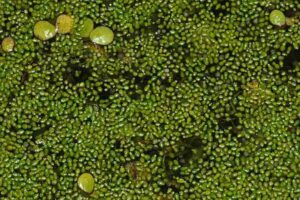
Cyanobacteria are photosynthetic microbes, often forming colonies in aquatic environments. They convert sunlight into energy through photosynthesis, forming the base of the food web. Their activities facilitate energy transfer to higher trophic levels.
Water lettuces contribute to nutrient uptake, while providing habitat, and shade. They facilitate energy transfer and support herbivores in the overlying trophic level.
*Trophic Level 2: Primary Consumers
Primary consumers here are; copepods, zebra mussels and tadpoles.
Copepods are herbivores that graze on phytoplankton, facilitating the transfer of energy from primary producers to the next trophic level.
Zebra mussels are filter feeders that extract phytoplankton and suspended particles from the water, impacting nutrient cycling. Facilitate energy transfer by consuming primary producers.
Tadpoles also consume primary producers, facilitating energy transfer from plants to animals. Form a link in the transfer of energy to the next trophic level.
*Trophic Level 3: Secondary Consumers
Secondary consumers in lake Food Chain 4 are; minnows and brine shrimps.
Minnows are omnivores that consume smaller fish, and various invertebrates including zooplankton like copepods. They facilitate energy transfer from lower trophic levels to themselves.
Brine shrimps are herbivores that consume phytoplankton, facilitating the transfer of energy from primary producers. Serve as prey for organisms in the next trophic level.
*Trophic Level 4: Tertiary Consumers
Trout, heron, and American coot are all lake tertiary consumers that contribute to biotic processes in the food web.
Trout are carnivorous fish that prey on smaller fish and invertebrates. Facilitate energy transfer from lower trophic levels to themselves.
Herons are predatory birds that feed on fish, amphibians, and invertebrates. Facilitate energy transfer from fish and contribute to the regulation of lower trophic levels.
American coots are omnivorous waterfowl that feed on aquatic plants, invertebrates, and small fish. Facilitate energy transfer from various trophic levels.
5). Food Chain 5: A Component of the Lake Food Web
Components: Cattails, bulrushes, water hyacinths, diatoms (Trophic Level)→Spiny water fleas, copepods, mayfly nymphs (Trophic Level 2)→Bluegill fish, frogs (Trophic Level 3)→Otter, bass, osprey (Trophic Level 5)
*Trophic Level 1: Primary Producers
Chain 5 of the lake food web includes producers like cattails, bulrushes, water hyacinths, and diatoms.
Cattails are emergent hydrophytes that provide habitat, stabilize the shoreline, and contribute to nutrient uptake. They support the transfer of energy to organisms in the overlying trophic level by serving as food resources.
Bulrushes are also emergent hydrophytes with nearly-identical characteristics to cattails, so that the names of these plants are used interchangeably. They provide habitat, stabilize the shoreline, and contribute to nutrient uptake. Their structure and functions facilitate the transfer of energy to organisms in the next trophic level.
Water hyacinths can be described as photosynthetic producers that provide habitat and cover for aquatic organisms. Contribute to the availability of plant-based resources, supporting the next trophic levels.
Diatoms (phytoplankton) are primary photosynthesizers that convert light from the sun into chemical stored energy, forming the foundation of the lake food chain/web. Their activities facilitate energy transfer to higher trophic levels.
*Trophic Level 2: Primary Consumers
The primary consumers in Chain 5 are; spiny water fleas; copepods, and mayfly nymphs.
Spiny water fleas are predatory zooplankton that contribute to the regulation of phytoplankton populations. Facilitate energy transfer by consuming primary producers and serving as prey for organisms in the next trophic level.
Copepods are also zooplankton, by are primarily herbivorous and graze on phytoplankton, thereby facilitating the transfer of energy from primary producers to the next trophic level.
Mayfly nymphs are versatile consumers that feed on algae and detritus, contributing to nutrient cycling. They facilitate energy transfer to higher trophic levels.
*Trophic Level 3: Secondary Consumers
Secondary consumers in this (chain-) segment of the lake food web are; bluegill fish, and frogs.
Bluegill fish are predominantly freshwater predators that consume smaller fish, as well as insects and zooplankton. They facilitate energy transfer from lower trophic levels to themselves.
Frogs are predators that consume insects, mayfly nymphs, and other invertebrates including detritivores like isopods and worms. Facilitate energy transfer from primary and secondary consumers to themselves.
*Trophic Level 4: Tertiary Consumers
Otter, bass, and osprey are the tertiary consumers in Chain 5.
Otters are tertiary consumers that feed on fish, crayfish, and amphibians. Facilitate energy transfer from lower trophic levels and contribute to the regulation of the lake ecosystem.
Bass are freshwater tertiary consumers preying on smaller fish, crayfish, and other aquatic organisms. They help maintain ecological balance by controlling populations of secondary consumers below them.
Osprey are tertiary consumers that primarily feed on fish, particularly those near the water's surface. These raptors help control fish populations and contribute to the dynamics of the lake's food web.
The Lake Food Web as A Product of the Recurrence of Organisms Across Multiple Food Chains
The recurrence of organisms in multiple food chains is a fundamental aspect of the complex trophic linkages that make up lake food webs.
This phenomenon enhances the intricacy and resilience of lake ecosystems, creating dynamic interactions among organisms at different trophic levels.
Some important points that illustrate how the recurrence of organisms contributes to the complexity of lake food webs, using examples from the previous discussions, encompass concepts like; interconnected trophic levels, shared primary consumers, omnipresent herbivores, predator-prey relations and dynamics, apex predators in different chains, and impact of invasive species. Each one of these concepts is discussed below;
1. Interconnected Trophic Levels
Diatoms, such as those discussed in Food Chains 1 and 5, are primary producers found at Trophic Level 1. These microscopic algae are part of the base of the food web in multiple chains.
The recurrence of diatoms in various food chains establishes an interconnected foundation for the lake ecosystem. As primary producers, they serve as a common energy source, supporting different organisms across trophic levels.
2. Shared Primary Consumers
Copepods and mayfly nymphs, cumulatively present in Food Chains 1, 2, 3, 4, and 5, are primary consumers at Trophic Level 2.
The presence of copepods and mayfly nymphs in multiple food chains indicates their role as primary consumers supporting different sets of secondary consumers. Their recurrence highlights the shared dependence of various organisms on common prey items.
3. Omnipresent Herbivores
Watermeal, water lettuce, and water hyacinths from Food Chains 1, 2, 4 and 5, are primary producers consumed by herbivores like tadpoles and mayfly nymphs.
The recurrence of these herbivorous organisms in different food chains emphasizes the widespread influence of certain primary producers on various trophic levels. The shared herbivores act as critical links, channeling energy from primary producers to higher consumers.
4. Predator-Prey Dynamics
Frogs and bass appear in multiple food chains (Chains 1, 3, and 5) as prey and predators respectively.
The presence of frogs and bass in various food chains exemplifies dynamic predator-prey interactions. These organisms not only influence the populations of primary consumers but also contribute to the availability of food resources for higher trophic levels, creating a network of interdependence.
5. Top Predators in Different Chains
Predatory birds like herons and ospreys are top consumers in Food Chains 2, 4, and 5.
The recurrence of top predators in different food chains demonstrates their adaptability and broad ecological influence. Herons and ospreys maintain control over different sets of prey species, shaping the overall structure and balance of the lake ecosystem.
6. Invasive Species Impact
Zebra mussels, mentioned in Food Chains 3 and 4, are invasive species affecting nutrient cycling and altering natural food web dynamics.
Invasive species, appearing in multiple food chains, can have cascading effects on the entire ecosystem. Their recurrence highlights the potential for introduced species to disrupt natural trophic linkages, impacting native organisms and altering energy flow patterns.
Generally, the recurrence of organisms in multiple food chains contributes to the intricate and dynamic nature of lake food webs. This interconnectedness enhances the resilience of ecosystems, allowing them to adapt to changes and maintain balance despite environmental fluctuations. These trophic linkages are important considerations for effective conservation and management strategies in aquatic environments.
Conclusion
The lake food chain comprises of;
1. Producers
2. Primary Consumers
3. Secondary Consumers
4. Tertiary Consumers
5. Decomposers and Detritivores
The lake food web is a non-linear model that reveals the actual complexity of organic interactions and feeding relationships in aquatic habitats.
For the purpose of simplicity in this article, this complex model is dissembled into a series of hypothetical food chains that can be individually studied and used to understand the repetitive linkages that create the food web. Below is a list of the individual food chains;
Food Chain 1: Diatoms, watermeal, bulrushes, water lettuce (Trophic Level 1)→Tadpoles, copepods, spiny water fleas (Trophic Level 2)→Crayfish, frogs (Trophic Level 3)→Northern pike, bass, pied-billed grebe (Trophic Level 5)
Food Chain 2: Cyanobacteria, water hyacinths, water lettuce, cattails (Trophic Level 1)→Mayfly nymphs, tadpoles (Trophic Level 2)→Brine shrimps, minnows (Trophic Level 3)→Heron, salmon, trout (Trophic Level 5)
Food Chain 3: Duckweed, diatoms, water lilies (Trophic Level 1)→Zebra mussels, copepods, mayfly nymphs (Trophic Level 2)→Frogs, crayfish, small crabs (Trophic Level 3)→Bass, northern pike (Trophic Level 5)
Food Chain 4: Watermeal, cyanobacteria, water lettuce (Trophic Level 1)→Copepods, zebra mussels, tadpoles (Trophic Level 2)→Minnows, brine shrimps (Trophic Level 3)→Trout, heron, American coot (Trophic Level 5)
Food Chain 5: Cattails, bulrushes, water hyacinths, diatoms (Trophic Level )→Spiny water fleas, copepods, mayfly nymphs (Trophic Level 2)→Bluegill fish, frogs (Trophic Level 3)→Otter, bass, osprey (Trophic Level 5)
